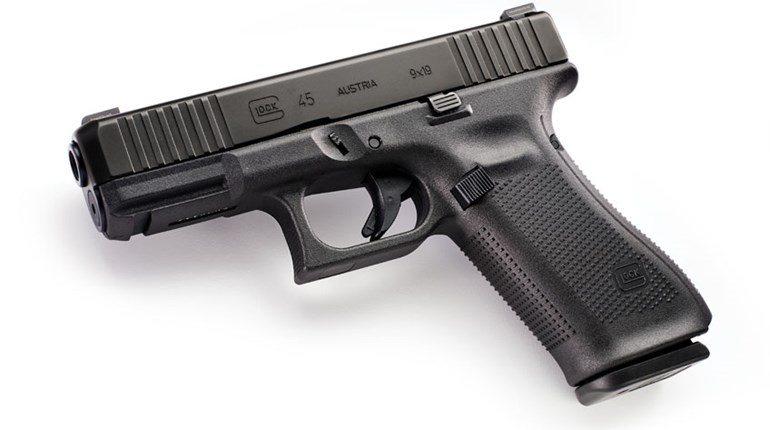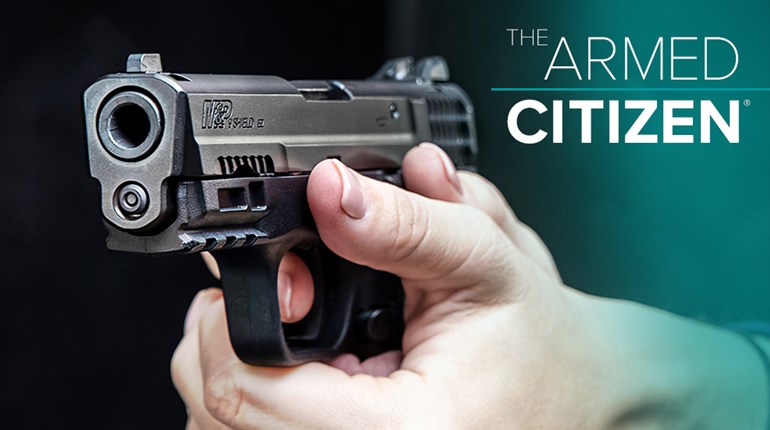
We test the Armatix iP1—a so-called “smart gun” touted by some to be the end-all answer to gun safety—and find it to be lacking in nearly every respect. Not where we’d park $1,800.
Since the introduction of the Glock 17 in 1984, it’s unlikely that any firearm has come to American shores amid more hoopla and anxiety than the Armatix iP1. Hoopla, because the iP1 is touted as a “game-changer” in terms of firearms safety through its theoretic ability to prevent unauthorized use. Anxiety, because it could set in motion state laws (notably in New Jersey) that will mandate similar technology on all firearms, whether safety benefits are real or imagined, and quite independent of whether the technology actually works.
The Pistol
The issue of Armatix GmbH of Unterföhring, Germany, it is the brainchild of Ernst Mauch of H&K USP and G36 fame (among many others). But this approximately $1,399 .22LR semi-automatic polymer and steel pistol principally owes its notoriety to one characteristic—a claim to the status of “smart gun.” While it can operate in an entirely conventional fashion, it can also, in the company of a specialized $399 wristwatch, take on a “smart” mode. Operation is then theoretically limited through RFID (radio frequency identification) technology to one user. Other features include an unusual slide design, conventional sights, a 10-round magazine and a sleek, ergonomic appearance. We recently had a chance to fire it under limited conditions.Pairing consists of selecting the correct mode on the wristwatch, entering an authorizing PIN, and bringing the pistol within 10 inches of the watch while the iP1 is held in a firing grip (backstrap “switch” pressed).
Our tests dealt mainly with the touted—and highly controversial—“smart” capability. Basically, this is a mode where the RFID electronics in the pistol are “paired” with the large wristwatch controller, and firing enabled. Pairing consists of selecting the correct mode on the wristwatch, entering an authorizing PIN, and bringing the pistol within 10 inches of the watch while the iP1 is held in a firing grip (backstrap “switch” pressed).
If the pistol and the watch communicate successfully, LEDs mounted in a translucent housing below the beavertail glow green, and the Armatix is ready to fire. A mechanical, trigger-mounted safety must also be in the “off” position to fire. Interestingly, this smallish safety control cannot easily be disengaged by a right-handed shooter with the pistol in a firing grip. The left hand must be employed.
A quick note here: Don’t confuse the Armatix technology with a biometric ID capacity keyed to a specific person, as seen in the James Bond movie Skyfall. If you have the wristwatch, time to access the correct mode, and PIN, you—or anyone else—can make the pistol fire. In fact, multiple shooters can do so after pairing occurs, as long as the backstrap switch is not released, and an activation time limit (set on the watch) doesn’t expire. An Armatix never paired with a wristwatch is like any other firearm: A charged magazine, a cycled slide, a pressed trigger = boom (sometimes, read on), authorized or not.
On the Range
Actual shooting proved interesting. After about 20 minutes, and under the ministrations of an IT pro with actual Armatix training, successful pairing was finally achieved with some difficulty. It’s our belief that arming would normally not take anywhere near this long, but don’t expect speed either. A “cold” start—with the watch on your wrist—should not be expected to take less than about 12 seconds due to apparently unavoidable delays in the watch/processor interaction. Such a regimen includes a minimum of seven button-entered commands/PIN digits. We didn’t try to arm the watch with only one hand available, but that would presumably be difficult.
Paired up slowly or rapidly, we eventually got it to work. Sorta.
First problem: Despite a decent single-action trigger, the longest string of fire any of our shooters achieved was nine shots (capacity is 10+1). Some shooters experienced three or four misfires while shooting a single magazine of ammo. Ammunition brand issues were ruled out using multiple examples from differing manufacturers. In theory at least, there was a ray of hope: As a single or double action semi-auto, when an ignition failure did occur, you could simply press the trigger again and fire in double action mode. (That’s little consolation, though, for failure to fire when the gun is “paired” with the watch and the trigger is pulled.)We guess we understand the red/green safe/hot LED pairings for fire control—it does match traffic safety conventions the world over. However, what it doesn’t match are firearms safety conventions the world over, where red uniformly means “hot.”
NRA-ILA staffer and USPSA Master Class shooter Josh Savani was at the testing and also had trouble getting the iP1to function. “Using premium ammunition, I could only get it to fire 4-5 rounds without a stoppage,” Savani said. “The range staff told us they couldn’t get it to run bulk ammo at all.”
The second problem was the pistol’s double-action press. It would be easily off the scale of any weight or spring-based measure we’ve ever used when testing pistols. Our experienced group of shooters often had to do a complete regrip of the pistol in order to exert enough force to successfully execute double action at all, much less accurately.
Savani was also concerned about the difficult trigger: “I wondered if some shooters would find it impossible to shoot this gun,” he said. “I bet the double-action trigger pull is 25 pounds, and no trigger gauge goes that high.”
You could, theoretically, thumb the hammer back after each shot to regain the relatively good single action. Nobody tried this, however, because it meant releasing the backstrap switch (though weak-hand thumbing might prove an awkward option).
This brings us to problem three: Being able to thumb the hammer back implies you can thumb it forward. Again, nobody tried—and for good reason. The deep slide recess that forms a channel for the arc of the hammer travel allows little purchase for any thumbing of the hammer. It’s clearly a potential safety issue if an activating grip is maintained, merely nervy if you trust hammer-drop safeties. But make darn sure the LEDs have gone red, otherwise, the pistol will still fire if you lose control of the hammer with a round chambered. In theory at least, this should never be necessary, but the urge to de-cock semi-automatics is still surprisingly pervasive, even when ill-advised.
Problem Four: We guess we understand the red/green safe/hot LED pairings for fire control—it does match traffic safety conventions the world over. However, what it doesn’t match are firearms safety conventions the world over, where red uniformly means “hot.”
Speaking of LEDs, there are two other colors you’ll need to learn (blue and white) that indicate magazine presence/absence. How this is a material improvement on simply looking, we can’t say. A decent base plate on the magazine makes it easy to tell if the mag is in or out.
We did like the magazine release, although it is of the European paddle-style on the trigger guard (think Walther P22 or PPQ M1, for instance), as opposed to the left side or reversible button on many other pistols (1911, Glock, M&P, etc.). The Armatix is also provided with a single, good quality magazine.
This is about all we could discover in our test, which could not include many expedients we would normally employ on a brand-new design, including dropping, induced stoppages and clearing, fouling, and—most important for a firearm with embedded electronics—immersion. The battery compartment did not appear sealed well to us, so presumably water could enter it very easily.
Gripes
The challenges of the iP1 are manifold. A simple one has to do with price: At $1,800 including the watch, this is an expensive firearm. Also, it’s not ideal for any firearms niche based on size, caliber, sights, trigger press or any other characteristic we could readily match to a present discipline. We think it’s mighty spendy for a plinker, but that’s your call. And if you are considering an Armatix as a defensive pistol, the historic deficiencies of the .22LR as a fight-stopper are well documented.
Another concern about “smart” technology struck us only after reflection, but with research, loomed horrifyingly larger: A reliance on technological safety features peculiar to individual firearms or systems will almost certainly blunt proven safety rules that apply to all firearms and always work when used. Long the core of NRA safety instruction, one of these is, “Keep your finger off the trigger until you are on target and ready to fire.”In a demonstration video for the national media, an American Armatix representative picked up an iP1 pistol by inserting her finger into the trigger guard of a cased pistol.
And before you think this is overstated, consider the following: In a demonstration video for the national media, an American Armatix representative picked up an iP1 pistol by inserting her finger into the trigger guard of a cased pistol. The journalist to whom she is demonstrating knows so little about firearms that he does not blanche even slightly at this gross violation of safe handling rules. In another video, a German representative repeats the same error. And the arming watch was well within 10 inches in both circumstances. A third video posted by Armatix shows a less serious violation (sweeping the left hand with the muzzle of a slide-locked Armatix in the right hand).
Final Analysis
In the end, we found the Armatix disappointing, and not, repeat not because of the technology—smart or otherwise.
If we chose to channel some inner Luddite, it would be politic to hate the iP1 on principle alone, but we can’t bring ourselves to that level of rancor. Other than a stratospheric entry cost and a steeper-than-usual learning curve, it can go bang, and Americans are Constitutionally entitled to own the firearms they wish. And as we’ve repeatedly said, the technology isn’t the problem, rather the bogus transliteration of “technology” to “safety” by mandate. However well intentioned such a mandate might be, meaningful liberty is still at serious risk.
Another worrisome detail is that the Armatix patent documents contain specifications for satellite-based or other at-a-distance “kill” switches (the Armatix “Target Response System,” for instance). Certainly, this should give pause to many who might otherwise find disabling technology appealing. Asking “who” has that shut-off switch in their control is certainly reasoned. “Why” is perhaps more troubling.
It’s also unclear to what extent this facet of RFID handshaking could be hacked (and a quick search of the Internet is not reassuring), either to arm misappropriated pistols, or shut off legitimately armed pistols. This is important–even crucial–if you are considering an Armatix as a defensive pistol, despite the deficiencies of the .22LR in such a role.
We submit that the possibility for remote, external neutralization of your firearm by anyone renders the right to keep and bear arms utterly moot, attacking every meaningful notion of ownership.

































